If Eric Clapton had decided to lie down his guitar and never play another note, his legendary stature in the history of popular music would still be secure. At the ripe old age of 23, he had lit the pop music world on fire with the Bluesbreakers and had finished playing with the first supergroup, Cream. He topped critic’s polls, had platinum albums and a huge house in the English countryside and everyone wanting to work with him. But at this point, he was trying to elude the spotlight and continue his musical journey out from under the microscope. The grueling pace of the Cream touring and recording had left him burnt out, and by the end of 1968, Eric Clapton was ready for a change.
His tenure in the short-lived Blind Faith would lead into a sideman’s spot in the Delaney & Bonnie group, then his first solo album and then into his masterpiece, Derek and Dominos’ Layla and Other Assorted Love Songs, which also featured Duane Allman. Though the album was a creative highpoint for Clapton, it initially fell on stony critical ground and did not sell like his previous efforts, which led to him to withdraw from the music scene altogether by the end of 1971.
The following article is an examination of the years between 1966 and 1969, which feature Clapton in the Bluesbreakers and the Cream. It seeks to discuss the more technical aspects of his guitars, amplifiers and style, and to shed more light on the components of his legendary sound. This story begins just after Clapton had left his first popular musical group, the Yardbirds and began the journey to destiny.
Bluesbreakers with Eric Clapton
In the middle of 1965, after parting ways with the Yardbirds, Clapton met up with the legendary John Mayall. John Mayall’s Bluesbreakers were a very popular blues band that worked the British club circuit. In addition to Clapton, Mayall later would also introduce such stellar guitarists as Peter Green and Mick Taylor through the band. Clapton was intrigued by the Bluesbreakers’ more traditional Chicago-style blues review and thought he might be able to make use of the rhythm section. As part of his initiation into the band, Eric spent a short period of time living at Mayall’s house, absorbing influences from the bandleader’s massive record collection and knowledge of American blues artists. Not one to waste any time, Clapton also carefully honed his already considerable chops into the legendary style that would soon make him famous.
Part of his vision for his new sound was finding a way to sustain notes like a slide guitar player or saxophonist could. He could hear a bigger sound, with a deeper, throatier tone that his Telecaster and Vox amp combination of the time did not give him. He began to seek out the proper components for his vision.
Sunburst of Your Love
His guitar of choice at the time was a 1959/60Les Paul Standard that he purchased secondhand from a local shop. Eric had admired the goldtop Les Paul held by blues legend Freddie King on an album cover and sought out a similar model for himself. King’s tone was raunchier and more muscular than the Tele/Vox combination Eric was using at the time and it perhaps acted as another impetus for Eric to work with the Gibson’s humbucking sound. (Note: Surely he had experimented with the humbucking sound before since he already had his ’64 ES-335, but the use of the Les Paul model by his heroes may have convinced him to try a Les Paul himself).
Now considered to be the pinnacle of solid body electric guitars, the 1958-1960 Sunburst Les Paul Standard was a move by Gibson to counter the rising sales threat posed by Fender and other electric guitar makers. While the sunburst finish was a tribute to the traditional Gibson finish, it was also to counter the falling sales of the Goldtop Les Paul models of the previous years. The Sunburst guitars featured a mahogany body and neck, a highly-figured or ‘flamed’ maple top and the first generation of humbucking pickups known as “Patent Applied For” (PAF) due to the sticker reading the same on the pickup baseplate. This is because the patent for the humbucking design had not yet been granted. These pickups have achieved legendary status among players trying to achieve the classic tone and now command thousands of dollars apiece! The original list price for these guitars was well under $300 in 1958.
Clapton has said the “Beano” Les Paul was one of his favorites because of its “slim neck” and the particular sound of that guitar. Unfortunately, no solid evidence pointing to the guitar’s exact year of manufacture has surfaced over the years, such as a clean shot of the guitar’s serial number or a firm recollection by Clapton. The “slim neck” reference could point to it being a 1960 model, and the guitar also sported a double-cream PAF in the neck position and a black PAF at the bridge when Clapton removed the covers. The volume and tone knobs also appear to be the tall reflector type, which could be interpreted as another 1960 reference. And the pictures on the Beano album show this guitar also had changed tuning machines, probably to Grovers, by the time of the recording. Clapton’s use of this Les Paul launched a legion of fans who rushed out to find similar models after seeing the guitar on the Mayall album cover. The Sunburst Les Paul now reigns as the most sought-after electric guitar by players and collectors alike, with prices now soaring past $200,000 for a prime example. Much of this phenomenon is due to Clapton’s influence nearly 40 years ago.
Stepping Out
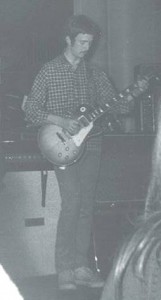
Arguably as important as his choice of guitar, his selection of the Marshall combo amplifier helped Clapton to realize his vision of a smooth, sustaining tone that could cut through the rest of the band and would give voice to the vocabulary of lines he had been building during the past year.
According to Jim Marshall, Clapton was mostly responsible for the combo amplifier being introduced into the Marshall line. His request for an amplifier that would fit into the “boot” (trunk) of his car seemed like a good idea. Their success with JTM-45 heads made them confident in their adaptation of the combo. These early combos used KT-66 tubes and very early Celestion Alnico 20-watt speakers.
Clapton had been in the Bluesbreakers during two different periods (April thru August 1965 & November ’65 until the start of Cream in the spring of 1966). During his first phase, he could have used the Series I combo, but in the picture beside, he is using a badge-logo JTM-45 atop a matching 4×12 cabinet. In other pictures from the Mayall period, you can see an earlier white-front JTM-45 head atop a black tolex cabinet. Since these pictures are undated, they can be used only to estimate the chronology of his amps, not define it. It’s entirely possible that he used this setup during his second period with Mayall, as well.
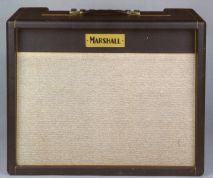
After his first stint, he quit to join a group of friends intent on traveling and playing around the continent. In Greece, Clapton was “kidnapped” by a local band, whose manager kept one of his Mayall Marshalls as insurance against Clapton’s leaving. It is unknown which amplifier he had with him. He did finally escape, but he had to leave the Marshall amplifier behind in the locked-up club. Perhaps it is still floating around Greece. He then returned to London with his guitar and rejoined the Mayall group in November of 1965.
When the Bluesbreakers recorded the “Beano” album in April of 1966, Clapton had acquired a Series II 1962 combo. This is model distinguished by the script Marshall logo and changes to the cabinet design, a GZ34 rectifier tube and other small circuitry changes. It is possible that the combo sported either the last of the Celestion G12 alnico or very early G12 25-watt ceramic speakers that featured a heavier magnet. Not to be confused with the normal G12M -25, the early G12-25 was considered a ‘heavy-duty’ version of the 20-watters, using the same cone kit, but with a heavier magnet. These speakers had a clearer, more chime-like sound than a standard G12M Greenback and was very difficult to distinguish from a 20-watter. Coupled with the output of the KT-66 tubes, the speakers provided a loud, open sound that had plenty of sustain.
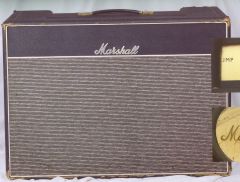
It also allowed Clapton to roll back the guitar’s volume to clean up the sound for chording or more subtle accompaniment. When listening to the Bluesbreakers Beano album, you can hear him adjusting the volume as he goes into and out of his solos.
The Rangemaster
While never confirmed by Clapton, another possible ingredient to his sound at the time was his alleged use of a Dallas Rangemaster treble-booster pedal, which he may have left on most of the time, adjusting his guitar volume for changes. These pedals are exceedingly rare these days and command quite a price for clean vintage examples. These were designed to give a treble and output boost to the guitar signal of the guitar, and Clapton could have used this to his advantage in the Bluesbreakers. The unit could have added a bit more sizzle and drive to the already overdriven tone of his Marshall. These pedals had only the one control knob, a short attached cord and no footswitch. It was meant to be perched on the amplifier and left on all the time. However, there is no photographic evidence from this period to confirm his use of the Rangemaster.
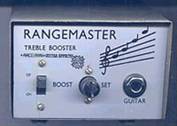
Fresh Cream
In the spring of 1966, Clapton, Jack Bruce and Ginger Baker began rehearsals for the band that they would later dub as the Cream. Eric was still using his beloved Les Paul and had probably moved to the new Marshall JTM100 amp and a matching 4×12 cabinet to better cope with Baker’s large drum kit and heavier sound. While the new amps still used an aluminum chassis and KT-66 output tubes, the output section had been beefed up considerably from 45 to 100 watts with four KT-66 output tubes and new 100-watt output transformers. The speakers were initially the Celestion G12M 20-watters in the earliest cabinets and were then upgraded to the heavier-duty G12H 25-watters in the cabinets that sport the “100” in the upper-left-hand corner.
The rehearsals moved along quickly as the band prepared to play out in the summer of 1966. Sadly, however, his treasured “Beano” Les Paul was stolen sometime in June or early July, leaving Eric to use a “borrowed” Les Paul to cut the band’s first disc, Fresh Cream. It was another Sunburst Les Paul of the same vintage, the exact year is unknown. This one had a more pronounced flame-top (probably points to a 1959 example) and a Bigsby vibrato attached. He also left the pickup covers intact, unlike his first one, perhaps because it was borrowed. The picture aside shows him playing this guitar at Windsor Jazz & Blues festival on July 31, 1966, so perhaps this is the one he used on the album.
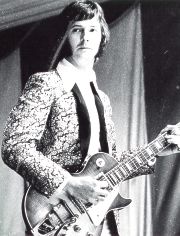 A third (!) Sunburst Les Paul shows up in slightly later pictures from the end of 1966 and early 1967. This one is probably a 1960 version, with the redder sunburst, uncovered black PAFs, stop tailpiece and a missing switch plate. Apparently he had borrowed this one from Andy Summers (the Police) and eventually “hassled” Andy into selling it to him. This guitar shows up in pictures going into the spring of 1967, but this one may have also succumbed to yet another thief at that time.
A third (!) Sunburst Les Paul shows up in slightly later pictures from the end of 1966 and early 1967. This one is probably a 1960 version, with the redder sunburst, uncovered black PAFs, stop tailpiece and a missing switch plate. Apparently he had borrowed this one from Andy Summers (the Police) and eventually “hassled” Andy into selling it to him. This guitar shows up in pictures going into the spring of 1967, but this one may have also succumbed to yet another thief at that time.
While it is possible that both of these guitars were used on the Fresh Cream album, the Les Paul sound is unmistakable on this recording.
The “loaned” Second Burst Listen to any of the cuts that feature a heavier sound and you can hear the magic combination of a PAF-loaded Burst into an early Marshall 100-watt head with KT-66s and 20-watt speaker cabs; it is loud, pure and full of sustain. On “Spoonful,” he effortlessly conjures massive tone and sustain, but can still turn the guitar down for beautiful clean tones. This responsiveness was crucial for Clapton’s style, as the Cream were a very dynamic band.
It is also an example of Eric’s resourcefulness in being able to locate and procure three of these particularly rare (in England at the time) guitars in such a short time. He had developed a bond with the sound and feel of this instrument and one can only speculate the sounds he would’ve conjured later on in Cream had he been able to keep one around!
Late in Cream’s tenure, he is shown playing yet another Sunburst in photos from the last American dates in the fall of 1968; again the exact year of the guitar is undetermined. This Burst also shows up in pictures from some Blind Faith shows in 1969 and is possibly the Burst he played during some of the ARMS concerts in 1983.

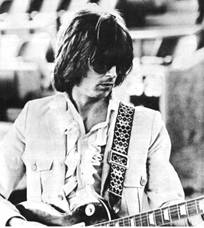
The Fool SG
In the spring of 1967, Eric acquired and began using the SG guitar that would become a cultural icon for the Summer of Love and beyond. By the end of 1960, falling sales for the Les Paul Standard caused Gibson to redesign the model and the version they came up with was known as the Les Paul SG (Spanish Guitar). However, Les Paul did not like the new design and asked that his name be taken off the model. By 1963, the guitars were known simply as SG Standards.
Initially, Eric’s SG Standard was reported to be a 1961 Les Paul SG, but closer examination reveals it to have been a 1964 model, because the number of screws in the pickguard had been increased to six for the 1964 model, up from five on the previous years, as the pictures below reveal. Note the circled area on the guitar.
You can see the additional screw just under the lower left corner of the bridge pickup. When he first began using the SG, it had the original Deluxe Vibrolo (tremolo arm) and it can be heard on several Cream recordings, both live and in the studio. However, this setup was eventually changed to a standard bridge and stop tailpiece, as the close-up photo shows. The new bridge assembly provided better coupling of the strings to the body and eliminated the tricky vibrato tuning stability. He also changed the tuning pegs from the standard-issue Klusons to Grovers, which was common change at the time.
By 1962, Gibson had begun transitioning from the Patent-Applied-For (PAF) pickups to those known as “Patent Number” pickups, meaning the patent for the humbucking design had been granted and the stickers on the backside reflected this. So it is amusing to note that one of the “classic” vintage tones on “Crossroads” and most of the post-Fresh Cream catalog was made using an SG Standard loaded with Patent Number pickups.
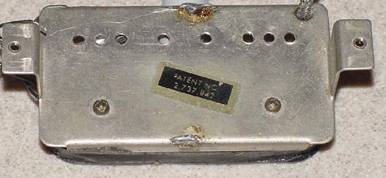
This particular combination does not have the mystique of a Burst with PAFs, but it does prove that the right player can make the different combinations sound incredible.
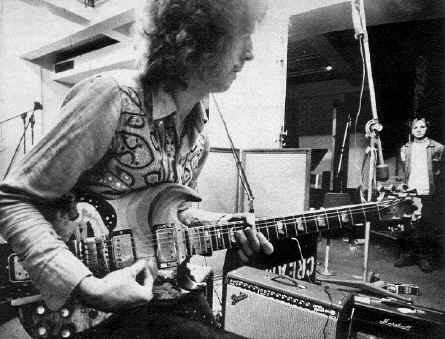
The famous paint job on the SG was provided courtesy of a Dutch painting duo named the Fool. The Day-Glo fluorescent paint scheme was already familiar in 1967 as the Summer of Love influences from the United States had begun pervading the youth culture of Britain. The Fool had also painted John Lennon’s Rolls Royce, George Harrison’s Stratocaster and Jack Bruce’s Fender Bass VI in a similar manner.
The SG was given a coat of a white primer, and then the oil-based paint color scheme applied to the entire guitar, including the back of the neck and the fretboard. However, Eric soon had the paint removed from both as it flaked off as he played.
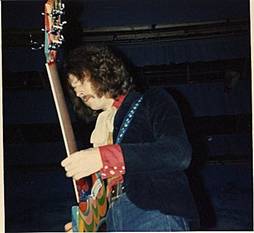
Eric used this guitar extensively live and in the studio during the rest of 1967 and into 1968. It is all over Disraeli Gears, Wheels of Fire and some of Goodbye and the subsequent live albums (Cream Live I & Live II). He must have formed a similar bond to this particular instrument as his first Burst, as there are many more pictures and footage of him with the SG than with another guitar during this period.
He later gave the SG to Harrison, who then gave it to singer Jackie Lomax, while Harrison was producing Lomax’s solo record in late 1968. Lomax eventually sold it to Todd Rundgren, who had it restored and the paint touched up. The guitar finally reached auction in 2000-2001 and was sold into collector’s obscurity. If any guitar deserves a home in the Rock and Roll Hall of Fame, it is Clapton’s psychedelic SG Standard.
The Les Paul Custom
During Cream’s trip to the US in April of 1967, it is believed that Eric acquired this black, three-pickup Les Paul Custom, which is an undetermined year, but is most probably between either a 1958 or 1959 model, due to the humbucking pickups.
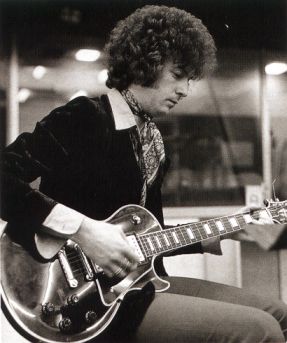
The Customs differ from the Les Paul Standard in that they the body is made of solid mahogany, with no maple top and ebony instead of rosewood fingerboard. While the three-pickup version is the most common, some from this era had only two pickups. Customs are noted for their brighter, quicker response and tone, mainly due to the ebony fretboard. This guitar would have had the PAF pickups and Clapton later removed the covers to reveal them.
This guitar was used as a backup for the SG on live dates during the same period and is featured on several songs on the Disraeli Gears album, such as “Strange Brew.” On some live shows in the last half of 1968, he may have used this Custom as the SG had probably become road-weary and was mostly de-commissioned by the latter part of 1968. He also used it during Blind Faith and the subsequent Delaney & Bonnie tour in 1969.
The Gibson Reverse Firebird 1
In the second half of 1968, Clapton began using a 1963-65 Reverse Firebird 1 guitar on most of the live dates, alternating between this guitar, the black Custom and the red ES-335. He finally settled on the Reverse Firebird I and the 335 as his main instruments for live shows, as pictures from the last tours indicate. These guitars featured 1 pickup, no switch, 2 knobs, stud tailpiece/bridge that the strings wrap around (though a spring metal Firebird III vibrato could be special ordered), an unbound rosewood fingerboard, and dot fingerboard inlays. The pickups were Firebird mini-humbuckers in chrome covers. It is probably a 1964 or 1965, since the pickguard does have the red, engraved Firebird on it, even though it is hard to see in some pictures.
Despite its size, the guitar had a thinner, more brittle sound than the other Gibsons and this is evident in the live recordings that feature it, such as the Final Concert, where he plays it during the first show. He also used it on the Super Session show in Dec. of 1968, where he is shown jamming with Buddy Guy.
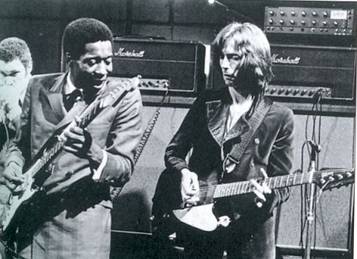
The 1964 Gibson ES-335 TDC
One of Clapton’s favorite guitars was his 1964 ES-335 TDC that he purchased new during his tenure in the Yardbirds. This red semi-hollowbody, twin humbucker guitar is said to have been on nearly every recording Clapton has made throughout the years. Early pictures show him (and bandmate Chris Dreja) with the guitar in the Yardbirds, then with the Cream during 1968, the Blind Faith album cover and even his recent Concert in Hyde Park video. Eric’s longtime tech, Lee Dickson has said that it is one of the greatest-sounding guitars he has ever played. Obviously, Clapton was greatly enamored with it, as it saw use over four decades.
This particular model is slightly different than 335s from the earlier era, in that it has “sharper” horns on the cutaway, block instead of dot inlays, Patent Number pickups and a non-sunburst or blonde finish. It was purchased brand new with the stop tailpiece and Kluson tuners with Eric’s earnings from the Yardbirds. He had seen his blues heroes sporting similar models and sought one out for himself.
According to Lee Dickson, the guitar had remained basically stock the entire time Clapton has owned it, save for a repaired volume pot and a fret dressing. As with his other Gibson guitars, Clapton changed out the Klusons for Grover machine heads. It also has apparently weathered the years well and does not show much wear at all. The original case also survived the years intact, still carrying the white-stenciled “Cream”
When Clapton decided to have a second auction of his guitar collection in 2004, he included this guitar, calling it the “star of the Show, really” even with his more famous “Blackie” Stratocaster on the block, as well. He explained that guitar had a significant personal value to him and had been present in all phases of his career. Clapton also added that “if you wanted to get into the actual pedigree of it, this is the Crossroads guitar.” While it is much more likely that the actual “Crossroads” live tune features the SG, there is always a possibility. And while it did not fetch as much as “Blackie,” the red 335 did command a huge price of $847,000, the most for any Gibson electric guitar. It is now owned by the Guitar Center corporation, which also purchased “Blackie” at the same auction. There are hopes for a national tour of the guitars so that everyone can see them and enjoy the tremendous heritage of these pieces.
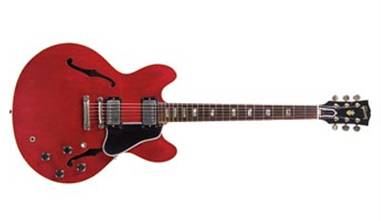
A unique tone that Eric developed during the Cream years was the Woman Tone, which is best exemplified on “Sunshine of Your Love” and “Outside Woman Blues,” from the Disraeli Gears albums. The sustaining, kazoo-like sound came from turning the tone controls for either or both pickups turned all the way off, sharply reducing the high frequencies, and the pickup volumes all the way up. This created a very thick tone that still had enough note definition and attack to be useful. Clapton used it judiciously to highlight passages or to create memorable melodies, such as on “Sunshine of Your Love,” where he includes a snippet of the tune “Blue Moon” in the opening phrase of the solo. In a live context, it also provided another dynamic element to his solos.
Another fine example of the sound is from the track “I Feel Free,” on Fresh Cream. His solo starts with the woman tone on the neck pickup in full glory, holding long notes and creating a liquid melody that leads to an abrupt change of tone during the solo’s final bars, switching to the bridge pickup’s hard bite for a stinging conclusion.
In the Farewell Concert video, there is a charming interview segment with Clapton, sitting onstage in front of his stacks, calmly discussing his playing style. When the interviewer asks about the Woman Tone, Clapton explains how to manipulate the guitar controls to achieve the sound and then demonstrates with a small but blistering handful of licks. He also gives a quick demonstration of the wah-wah pedal, too.
Tales of Brave Ulysses
In Cream, the most recognizable effect was the wah-wah pedal, featured prominently on songs like White Room and tales of Brave Ulysses. Clapton credited Hendrix with introducing him to the sound, via Hendrix’s “Burning of the Midnight Lamp” tune. While Cream was recording Disraeli Gears in New York City during the spring of 1967, Clapton picked up a very early version of the Vox wah-wah at the famous Manny’s Music on 48 th Street and began using the effect on some of the Disraeli Gear tunes. It figures prominently in his first composition for the band, “Tales of Brave Ulysses.”
He incorporated the pedal into his live rig, though it would sometimes be unplugged until it was needed. It added a little more color to his tonal palette, but he used it sparingly, as he did with the Woman Tone, to provide some distinction to a phrase.
Despite many claims, rumors and supposed “breakdowns” of his Cream gear, Clapton usually had only the wah pedal between his guitar and amps in a live setting. It appears that he did not use the Rangemaster or other device, such as a Fuzz Face, to achieve his massive sound. Pictures and footage from the live Cream era show only the Vox wah-wah on the floor, with no additional pedals in evidence. The coupling of the Gibson guitar, Marshall amps and his fingers were all that was necessary to create his tone. However, in the studio, he may have used some outboard or pedal effects to achieve a desired sound.
Walls of Fire
By the time the Cream was playing out in the summer of 1966, they had acquired full stacks. In June, 1966, Marshall had not yet opened the factory or begun full production of the amplifiers. All of the amps would have to have been by special order. However, Eric was well-known to Jim Marshall, so it is easy to believe that he would’ve been able to sample the amps and choose his favorites. Eric was using a single JTM100 stack, and Jack was playing a 200-watt Major prototype through two stacks to keep up. It is possible that they were both using the cabs with the 100-watt logo and 25-watt speakers to prevent constant speaker failure.
Eric’s main rig at the beginning of Cream consisted of a JTM 100 model 1959 Lead amplifier, probably with an aluminum chassis, Drake transformers and GEC KT-66 output tubes. These amps are what define the early Cream sound, which has less distortion and more of a clear sustain than later models. Part of this is due to the high plate voltage of the KT-66s, which drove the tubes harder, while still allowing some clean headroom to their sound. Another component is the lower-wattage speakers used (20 or 25 watters) that allowed for more compression at high volumes and made it easier to get a smooth feedback/sustain from the amplifier. In pictures from this period, Eric is usually positioned right in front of the stack, presumably to take advantage of this ability.
Fresh Cream and Disraeli were certainly JTM100, simply because the JMPs models did not arrive until the beginning of 1967. Considering the cost of new Marshalls at the time, it’s also reasonable to assume that the amps used in early ’67 were in fact ’66 JTM heads.
The early Marshall cabs had both G12M 20w and the cabs with “100” logos in the corners were G12H 25 watt ceramic magnet models. The bottom or “B” cabinets were the taller variety, in that they were a few inches taller than the regular 4×12 cabinets. These cabinets also featured the “pinstripe” grill cloth, which preceded the basketweave cloth used by Marshall after late 1967 or early 1968.
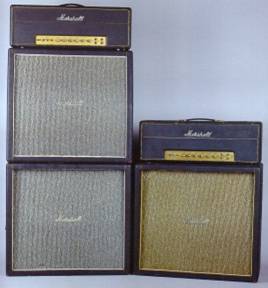
After their first tours of the US in 1967, the Cream returned to England, where they replaced some of their worn gear. Eric still used the Superleads, but Marshall had begun using EL-34 tubes instead of the KT-66s. The EL -34 might have been substituted as being a more reliable tube than the KT-66, which also may have begun to dwindle in supply. The switch gave the Superlead’s sound a harder edge and more distortion when full up. And by this time in 1967, the Celestion 30-watt G12H heavy-duty speakers were available and Cream’s road team may have begun using these to limit the amount of speaker failures. The speaker’s increased power handling led to less speaker compression, which also affected his ability to get his desired sustain at a manageable volume. These changes are important factors in leading to a more aggressive sound for Clapton in the second half of Cream.
Eric had upgraded to two full stacks for live shows and he used both heads, sometimes joined by a simple splitter cable or a by using a jumper arrangement between the two heads. The jumper arrangement consisted of plugging into one of the heads and then using another cord plugged in to the input below the first to share the signal with the second head. Most photos show a splitter or Y-cord feeding the amps. It does not appear that he used the common practice of jumpering the two channels together to mix the channels sounds, either.
It is also important to note that Clapton always plugged into the second channel or “Normal” high-sensitivity input on his Marshalls. Most everyone, including Townshend and Hendrix, would use the first or “Brilliant” channel, which has a more trebly sound. The normal channel rolled off some of the high frequencies, and reduced the harsher edge of the distortion. In later interviews, Clapton said he liked to roll off some of the guitar’s tone control to achieve a “darker” tone. And many pictures show the guitar’s pickup selector in the middle position, to mix the lead and rhythm pickup’s sound, further softening the high end response. His live tone during this period was always loud, clear and present, yet never harsh or piercing.
By using the two stacks, Eric generated a bigger sound field to help him generate his required sustain and feedback. Latter-era Cream pictures show him more to the side, standing closer to the drums on his right and not directly in front of the stacks. With both stacks on full, playing out in front of them would have meant almost total feedback of the unpleasant microphonic variety during any pause of signal. Guitar pickups of that era were not potted or shielded for the kind of high-gain Clapton was using. By moving closer to the stacks, he could generate the desired feedback on demand. And by moving away from them, he could retain control over the feedback and still hear himself over Jack and Ginger. In Cream, the use of multiple stacks was a necessity for each member to hear himself and for the audience to hear the band.
Today, the sight of a wall of Marshalls is very familiar backdrop to concerts and videos, and most of the time, they are purely for show. Often the guitar player will have only one head and cabinet actually on and fed through the PA, while the rest are used to create the image of a massive, imposing system. With the advances in PA and monitor systems, the need for a huge stage volume has waned. Separate mixes for the front of the house and the stage performers allows for a comfortable volume onstage and a pleasant sound for the audience, who never hears any actual stage volume.
Those Marshall stacks must have been a truly impressive sight and sound during the days of Cream. And the visual aspect, the iconic impact of a stack of amplifiers onstage was simply borne out of a necessity to achieve and present a desired tone, not to look impressive.
Those Were the Days
By the end of the first major US tour in 1968, which produced the Wheels of Fire live segments, the band began to show the strains of constant touring, the in-fighting between Baker and Bruce and Clapton’s growing restlessness. He had begun listening to more structured songwriting from people like The Band, Bob Dylan and other songwriters and felt he was simply going through the motions on the monumental jams Cream made famous. A highly-critical review in Rolling Stone that spring contributed to his announcement to his band mates that he was through. Bruce and Baker had reached a similar point of frustration and they agreed to split up the band. The rest of the of 1968 was spent finishing the studio portion of Wheels of Fire and doing a farewell tour of America that ended in November.
Cream returned to the UK and performed their last two shows on Nov. 26 th at London’s Royal Albert hall. Both of the shows were filmed for a BBC documentary, which is available as Cream’s Farewell Concert. The hometown crowds gave the band such a warm reception, the band briefly considered staying together. But after the concerts, they assembled only  to finish some new material for their appropriately-titled final album, Goodbye. Goodbye also featured three live tunes taken from the last US tour and a leftover Fillmore performance from the first 1968 US tour. By then, the band was completely exhausted and spent of any collaborative effort, so they each made their own way into the post-Cream world.
to finish some new material for their appropriately-titled final album, Goodbye. Goodbye also featured three live tunes taken from the last US tour and a leftover Fillmore performance from the first 1968 US tour. By then, the band was completely exhausted and spent of any collaborative effort, so they each made their own way into the post-Cream world.
They left behind a true legacy of musical innovation on a number of fronts. The Cream was one of the first bands to undertake a major US tour as a headlining act, not as a part of a packaged show or revue, and commanding the largest fees up to that date. They also pioneered the “jam” aspect of rock, leading to any number of lengthy, lesser-inspired or performed drum solos, bass solos and guitar forays. The Cream’s “heavier” sound also spawned legions of imitators, some of whom actually took the baton and created their own new forms of rock, such as Led Zeppelin, Black Sabbath and Deep Purple. The term “virtuoso” became more commonplace in referring to a rock musician because of the stature in which Baker, Bruce and Clapton were regarded. And, they accomplished all of this in less than three years.
Clapton, while embarking on a lower-profile career post Cream, has still retained his status as a pioneering, influential and pivotal legend in the world of rock music and beyond. His legacy continues with his recent recording and touring, while his influence spreads to yet another generation of players and listeners.
References (Books)
Clapton – A Biography (1988) by Ray Coleman
Cream: The Legendary Sixties Supergroup (2001) by Chris Welch
Crossroads: The Life and Times of Eric Clapton (2003) By Michael Schumacher
Magazines
Guitar Player Eric Clapton special issue (August, 1985)
Guitar Player Eric Clapton interview (April, 2004)
Websites
An excellent Cream site is located here:
http://twtd.bluemountains.net.au/cream/contents.htm
Videos
Fresh Live Cream (1993). This excellent documentary features plenty of live video and film of the group during its heyday.
Cream’s Farewell Concert (release date unknown) Though this is a dated effort with many psychedelic attempts at grooviness and brutal editing of some of the material, it is still an essential for the fan of Cream. It is also the closest to an “instructional” video of the Cream, with each member giving a short tutorial on their style and equipment.
The Author Thanks
The author would like to thank Graeme Pattingale of the above site for all of the information and many of the photographs used in this article.
Another thanks to Ted Breaux for his invaluable technical information and review of the document.
And a very special thanks to David Szabados and LegendaryTones for the opportunity to write this piece and an amazing amount of patience!
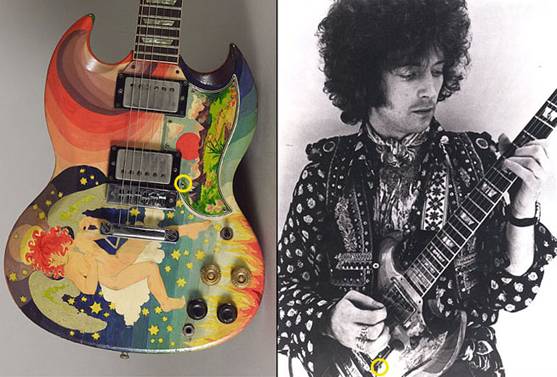
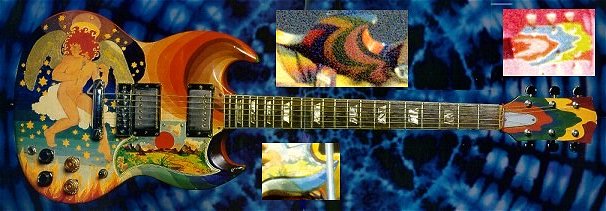
Great info here, Thanks
Perhaps no other legendary 60’s band had it’s video history more poorly preserved than Cream.
Gibson SG stands for “Solid Guitar” not “Spanish Guitar”. In Gibson ES series like the ES-335 and ES-175, the ES stands for “Electric Spanish”.
Nice write up! I believe the interviews incorporated into the farewell cream program were shot some six months earlier, and were done at a music store (Mannys’, in NYC?) while Cream were touring. You can clearly see that their hair is different length from what is seen at the RAH in November, as well as changes in facial hair.
Also – the borrowed LP with Bigsby has been mentioned as possibly being Keith Richards’ guitar, as seen on TV and live appearances in the ’64-65 era Stones (Ed Sullivan, TAMI show, etc.). Andy Summers tells in detail about selling EC the second sunburst LP in his autobiography One Train Later.
very true, sadly. Many other bands of the era were not documented well at all – the 1st Jeff Beck group comes to mind.
Yes, but I remember seeing one very decent video shot at the Fillmore East. That alone surpassed the dregs that passes for Cream footage.
You mean Fillmore video of the JBG? I’ve seen BW video footage, but not with audio. If you know where I can see see that, please feel free to point with a link? Given Cream’s lasting influence and importance (which I think was not fully comprehended at the time), your original comment is all too true…Oh, to have a time machine…
Don’t get me started on time machines!!! Yeah, if I find that video I’ll send a link. It’s probably on Traders Den. I’ll get back to ya.
Is 1972 (ugh!) close enough? Or did you want the JBG with Rod Stewart. This is from Germany in 1972
http://www.thetradersden.org/forums/showthread.php?t=119334&highlight=Jeff+Beck+Group
This, unfortunately, is audio only, from Fillmore West, 1968
http://www.thetradersden.org/forums/showthread.php?t=102490&highlight=Jeff+Beck+Group
Thanks Duke! Yeah, I meant the Rod group. There is indeed some very decent audio boots out there…that band was on fire for a while there. Beck’s playing live was way beyond what “Truth” LP only hints at.
But I have seen this ’72 stuff with the second group, very glad at least that was captured for posterity!
Ironically enough I never cared for Beck. Or Jimmy Page for that matter. My #1 was Clapton, then Hendrix, followed by, in no particular order, Johnny Winter, Alvin Lee, Leslie West, Martin Barre (from Tull) and Mick Taylor.
Clapton wrote the book for all those guys imo. As a guitarist, I’d count him as one of the few great innovators who changed the way we all play (with Charlie Christian, EVH, Wes Montgomery and Hendrix).
Who am I to argue? ;-)
Sometimes I’ll imagine Page ripping the plastic off Wheels of Fire and listening to Crossroads for the first time. Must have cr@pped his nappies ;-)
Two minor corrections-The SG in Gibson’s SG stands for Solid Guitar, not Spanish Guitar and The Fool did not paint George Harrison’s stratocaster, he did it himself.
Although no fault of your own, its amazing how disinformation sticks to the internet like a virus….for the record to those who care, Clapton NEVER used his Gibson ES-335 during the US Cream Farewell tour between October 4 and November 4 1968 or at any time earlier during his tenure with Cream….he ONLY used the 335 with Cream during their FINAL FAREWELL PERFORMANCE AT THE ROYAL ALBERT HALL DURING THE REHEARSAL PUBLICITY SHOTS (WHERE HE’S WEARING A BLACK LEATHER JACKET) AND DURING THE SECOND SET OF THE CONCERT, AS SEEN IN THE MOVIE. HE USED THE FIREBIRD DURING THE FIRST SET. EC DID USE THE 335 THE FOLLOWING YEAR DURING THE BLIND FAITH US TOUR AND IN EUROPE. During Cream’s US Farewell tour, Clapton ONLY used two guitars, 1 Les Paul Standard he exchanged with Paull Kossoff and 1 Gibson reverse Firebird. Before the Farewell Tour between the fall of 66 and June 68, he used a variety of Les Paul standards (including his Black Beauty), his main axe, the SG Fool and eventually the Reverse Firebird.
Clapton basically used 3-4 Les Pauls during early Cream to replace his Beano Les Paul that was stolen during early Cream rehearsals, then after obtaining his coveted Gibson SG Standard around late December 66, (& had it painted by the Fool) it became his PRIMARY axe for the bulk of Cream’s recordings (Disraeli Gears & Wheels of Fire) and nearly every live performance from May 1967 all they through the grueling Disraeli Gears tour that stretched to June 1968 including the performance I witnessed and will never forget sitting 15’ in front of EC playing his SG through a massive dual Marshall stack. The soaring, majestic tone he got out of that SG through the dual stacks was phenomenal, and was consistent with how he sounded on the famous live Crossroads and most of the live Cream tracks except massively louder and spine breaking, truly exhilarating. As a 15 yr old, it changed my entire approach to guitar permanently as well as generations to follow (see my old Cream Brownie camera photos attached from April 19, 1968 at Philadelphia’s Electric Factory).
This erroneous myth that EC used the 335 with Cream at any time before their final November 26 concert at the Royal Albert Hall, was created by the Burst Brothers after they bought the 335 at the Christies auction and in order to “hype” it, they literally fabricated the astounding myth that Eric used it throughout Cream which is tantamount to claiming Clapton used a Ventures Mosrite guitar with the Bluesbreakers, or that Donald Trump is actually Eric Clapton……total bull sh.t:-)
I don’t know what it takes to correct the astounding lies that perniciously permeate the internet creating history revisionism. Another Clapton myth, that is quite malicious, asserts his iconic live Crossroads solo was edited….it was NOT!!! Confirmed by both the engineer that worked the boards and mixed the recording and by bootleg hand held audience recordings definitively proving that the live Winterland Crossroads of March 10, 1968 was performed exactly as you hear it.
maybe Page was nothing without Plant…